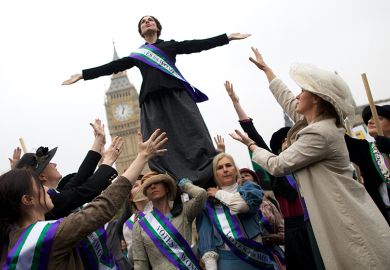There was once the homologous humoural body. Women were lesser, wetter and colder than men - "physiological depressives" - with internal rather than external sex organs. But they were not essentially distinct from men. Then, in the late 17th century, came Thomas Willis and the science of neurology. This delivered the differentiated pathologised body that had either a penis or a uterus. A different body meant a different and smaller female brain, emotional rather than intellectual equipment. Women moved from being sexy weaker vessels to becoming superior moral agents and the modern ideological construction of gender was born. Feminism, which developed this history, relocated the great Foucauldian episteme (once placed in manly style at the end of the 18th century with the masculine revolutions) to the end of the 17th century when the bodily change was occurring. Patriarchy was seen to be reformed by replacing its ancient medical and scriptural basis with a new secular ideology of gender.
This thesis with ornaments - Alice Clark's golden age of communal labour was grafted on to provide a precapitalist utopia to contrast with present patriarchy - became engrained in literary and cultural studies of the new historical sort based primarily on written texts. Historians either modishly accepted it or grumbled in monographs with small print runs. Now, in these two huge synthesising books by the distinguished historians Anthony Fletcher and Olwen Hufton from Essex and Yale Universities, history strikes back. The thesis is swamped in a mass of detail and specificities that argue that women's habits, lot and reactions remained much the same through the three centuries between 1500 and 1800. Straightforward old-fashioned biology counts for much since a pregnant woman could not "plough a five-inch furrow" in Hufton's words; Jane Adams, calling the widow Elizabeth Dodge a "common whore, hot ars't bitch and as common as the highway", could have been speaking in 1600 as well as in 1800.
Hufton's subject is squarely the history of women throughout western Europe (with an emphasis on her speciality, France). In her enterprise she is unapologetic about lumping periods and places together since existence in previous centuries had material and physical constraints that necessarily impeded change over a long time. Consequently she swerves from the Foucauldian notion of changing mentalities to base her work more clearly on that of Fernand Braudel who, though largely ignoring women, emphasised the practice of everyday material life, which, being based on land, was largely unchanging.
Generalisations are made appropriate in a book where ideas of gender are only one thread in a web of beliefs and activities. Given her general thesis, Hufton inevitably takes issue with the grand narrative historians, with Lawrence Stone and his growth of affective individualism, with Phillippe Aries and his development of feeling for the child, and with Elizabeth Badinter and her thesis of mothering as an invention of capitalism. The work of all these is destabilised by detail, by what Hufton calls real-life situations.
In passing, Hufton makes many points against received opinion, the modern cliches of women's studies, history and literature. For example, the legal authority, the great bugbear William Blackstone, whose remarks on women and men as one entity open many a scandalised undergraduate's paper. He in fact thought that English law lifted too much from the shoulders of women and urged that some of the distinctions between husband and wife before the criminal law be removed. She also points out that, contrary to popular belief, in medieval England the convent was never a major absorber of single women; that preindustrial cities were predominantly female; that, in stark contrast to the notion fostered by stoical advice books, early modern women were not spared grief for child deaths; that wet-nursing was not common, being confined to only about 4 per cent of children and being used as much by working women as by aristocrats; and that a dowry was not a sign of servitude since it alone gave women significance where Roman law operated: with one, a woman could have a husband on terms of respect but, without one, she was a slave.
Hufton's book is a rich potpourri of activities. Dirt and rituals of washing were forced into symbolism, she reveals: the water in which the newborn baby girl was washed in southern Europe was tipped over ashes in the hearth to keep her at home, while the water used for a boy was thrown outside to suggest he must deal with the world. Likewise, one peal of bells announced the birth of a girl, three a boy. Brilliantly, Hufton captures the sense of female activity which one tends to forget when reading the novels of semileisured 18th-century women whose conventional subjects were romance and courtship or indeed conduct books concerned with an ideal in ideal circumstances: the way women, refused opportunities for work through men's closed practices, squeezed into cracks, making loose mantuas when they were kept from tailoring, selling cooked meals to their neighbours or to prisoners when excluded from catering trades. Hufton constantly reminds us that, at the bottom levels of the rural population where most women existed, life was a remorseless struggle against poverty, a foraging for food and firewood, and an unremitting war against disease and lice. Discussing literature only occasionally, she spends time with the illiterate, the mute, the people largely below fashion and cultural influence.
Anthony Fletcher's almost equally large book is different from Hufton's and its overall failure, despite great richness of detail, suggests the difficulty of his enterprise. For, although the effect of both the two books is to oppose grand narratives, Fletcher only implies his opposition against an expressed intention of supporting them. His aim, he claims, is to show the changing attitude to gender over three centuries (though, as he admits, his emphasis is very much on the late 16th and early 17th centuries in Britain). Where Hufton stays mainly with the material, Fletcher discusses the written, the fantasised or intended, insisting that women and men were made not born. (Hufton warns that this is only partly true.) To try to hold to the thesis of cultural change, Fletcher flattens disciplinary boundaries and ranges in a postmodern fashion over Branagh's Shakespeare and Foucault. He then settles down to the empirical and anecdotal, providing a kind of academic "weaker vessel", quoting often from conduct books, sermons, and occasionally from canonical literature. He returns to the thesis at the end, but in its achronicity and material detail the bulk of his book only suggests what Hufton's work argues: that men and women are much the same at any point and that there is little ideological change. It was not for nothing that Foucault fought shy of multiple examples in his work.
Since he has stated he intends to use literature as evidence, Fletcher lays himself open to charges of omission, naivete and indigestion. Why is so little made of Paradise Lost which seems so seminal to many critics, of Rochester and Hobbesian court culture? Why are Shakespeare plays used for what any letter could have delivered? The oversourcing to secondary sources and the undersourcing to original works make Fletcher's book a useful bibliographical tool for a student about to write an essay, but not so attractive for a general interested reader who would prefer to be pointed towards original material and would often like to know the dates of quoted words.
A rebuke of Fletcher for his use of literature comes implicitly from Hufton, who reminds us that conduct books and writings are fictional, products of imagination. Indeed, what Hufton blames the "middle-class university educated spinster" Alice Clark for could be said of Fletcher: not so much that Clark wrote her contemporaries into her script as that, to advance a thesis of serial decline from healthy activity to idleness or exploitation, she used prescriptive literature and assumed that identity could produce reality.
With her clear enterprise of charting women's predominantly material history, Hufton has an easier intellectual time of it than Fletcher. But while Fletcher's approach may be qualified by hers, it is certainly not invalidated. What his study suggests is rather the difficulty of his aim - to chart the history of changes of thought or systems of apprehending the world using both empirical historical data and imaginative literature. His relative lack of success may indicate the limits of the now-common emphasis on interdisciplinarity, so exciting when it first began to break down barriers. At times this interdisciplinarity, manifesting itself in a shared language of analysis that crosses history, literature, sociology and politics, can result in an eliding of difference between disciplines, so that what was potentially a revealing and provocative argument settles down into a cosy and stifling agreement - all very suitable for these crazy days in which academics in the humanities are forced to narrate their business as if it were the collective work of a single laboratory.
To return to the ideological gender shift with which I began, then. Such a thesis can be extremely provocative and useful as an entry into an investigation of literary or cultural history, helping to catch for us now the otherness of past subjectivities. There does remain a place for nonmaterialist analyses of women (and men's) past and of gender such as Fletcher proposes. But the use of large theses, the working out of them, the supporting or undermining of them, as well as the refining of their inevitable crudity, might well best be left to individual disciplines with their own specific tools for coping with the complex interplay of mental and material phenomena. Within the study of literature, the subtle changes in gender or any other psychological facet of humanity need to be carefully teased out of rich individual texts using literary analysis; the empirical data of historians cannot simply refute or negate the results. If, then, the intentions of Hufton and Fletcher could seem to be in creative conflict, this is perhaps a useful reminder that the same might be said of the disciplines of history and literature.
Janet Todd is professor of English literature, University of East Anglia.
Gender, Sex and Subordination in England 1500-1800
Author - Anthony Fletcher
ISBN - 0 300 06531 0
Publisher - Yale University Press
Price - £25.00
Pages - 442
Register to continue
Why register?
- Registration is free and only takes a moment
- Once registered, you can read 3 articles a month
- Sign up for our newsletter
Subscribe
Or subscribe for unlimited access to:
- Unlimited access to news, views, insights & reviews
- Digital editions
- Digital access to THE’s university and college rankings analysis
Already registered or a current subscriber?



